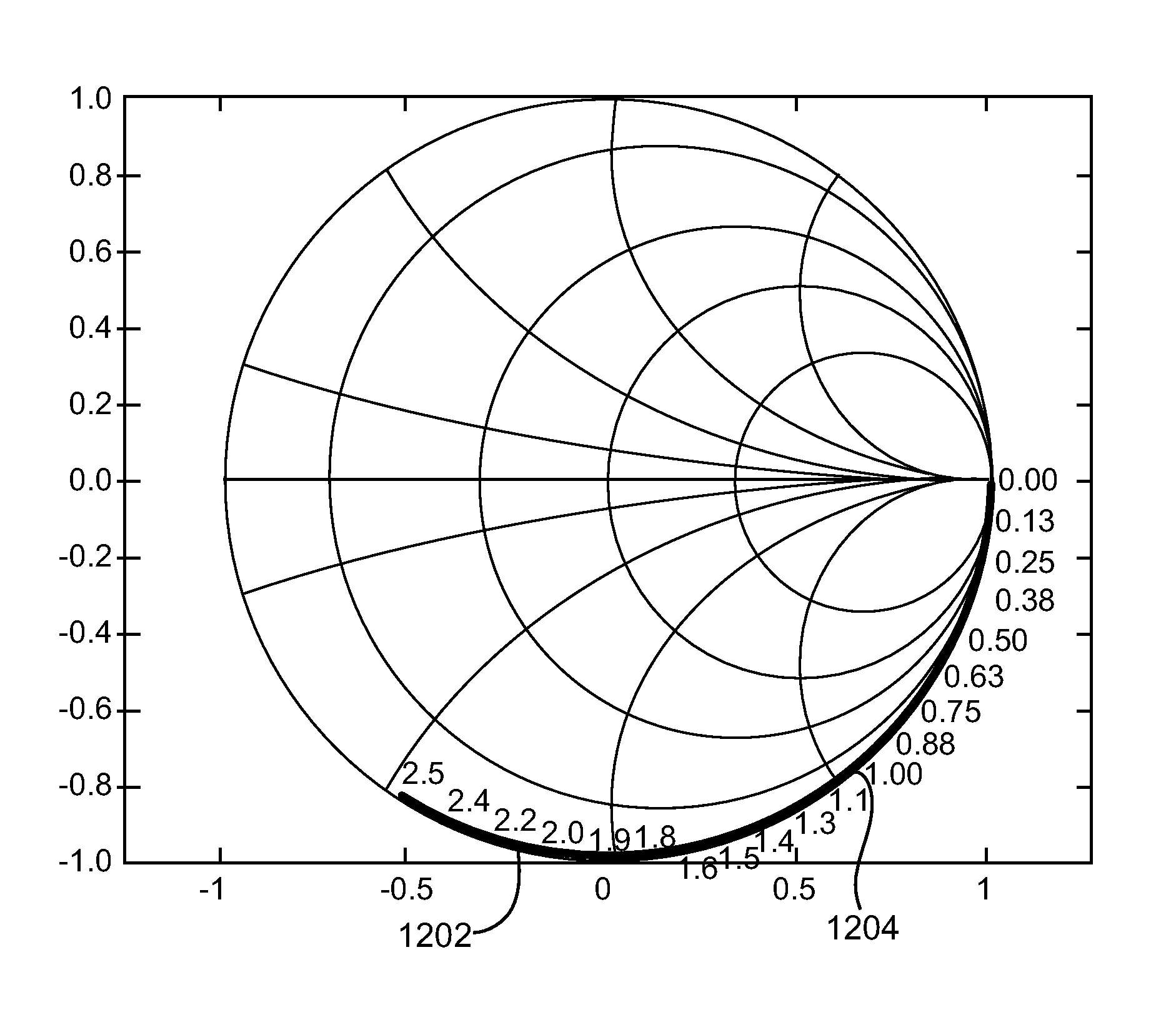Use of smith chart to compensate for missing data on network performance at lower frequency
a network performance and data technology, applied in the field of frequency dependent behavior characterization of passive electrical networks, can solve the problems of insufficient theoretical calculations and simulations to predict the behavior of frequency dependent devices, serious inaccuracies in the inverse transformation process, and significant yet unpredictable impact upon impedance matching, etc., to achieve the effect of convenient acquisition
- Summary
- Abstract
- Description
- Claims
- Application Information
AI Technical Summary
Benefits of technology
Problems solved by technology
Method used
Image
Examples
example 1
[0091]FIGS. 6A-6B are illustrative graphical representations of Smith Chart plots of S11 and S21 frequency signature traces respectively, for a microstrip transmission line. The S11 plot represents a reflection coefficient at port 1 of the transmission line. The S21 plot represents a transmission ratio from port 1 of the transmission line to port 2 of the transmission line. The solid lines 602, 604 designate first plots comprising measured scattering parameter data. The dashed lines 606, 608 designate second plots comprising extrapolated scattering parameter data using the approximated method. The scattering parameters in this example were obtained via measurements on a network analyzer.
[0092]FIGS. 7A-7B are illustrative time domain transient simulation results corresponding to the frequency domain traces of FIGS. 6A-6B, respectively. The first traces 702, 704 and the second traces 706, 708 correspond to the sending and receiving ends of the transmission line respectively. The no DC...
example 2
[0093]FIGS. 8A-8B are illustrative graphical representations of Smith Chart plots of S11 and S21 frequency signature traces respectively, for I / O channel trace. The solid lines 802, 804 designate first plots comprising measured scattering parameter data. The dashed lines 806, 808 designate second plots comprising extrapolated scattering parameter data using the approximated method. The data in this example were generated using a field solver.
[0094]FIGS. 9A-9B are illustrative time domain transient simulation results corresponding to the frequency domain traces of FIGS. 8A-8B, respectively. The first traces 902, 904 and the second traces 906, 908 correspond to the sending and receiving end of the I / O channel, respectively. The no DC extrapolation result in FIG. 9A shows that the smaller crosstalk waveform does not settle to zero. The result using a DC extrapolation result in accordance with an embodiment of the invention in FIG. 9B shows the smaller waveform settling to zero.
example 3
[0095]FIGS. 10A-10B are illustrative graphical representations of Smith Chart plots of S11 and S21 frequency signature traces respectively, for microstrip line. The solid lines 1002, 1004 designate first plots comprising measured scattering parameter data. The dashed lines 1006, 1008 designate second plots comprising extrapolated scattering parameter data using the approximated method. The measurements in this example were obtained from a network analyzer.
[0096]FIGS. 11A-11B are illustrative time domain transient simulation results corresponding to the frequency domain traces of FIGS. 10A-10B, respectively. The first traces 1102, 1104 and the second traces 1106, 1108 correspond to the sending and receiving end of the microstrip line, respectively. The no DC extrapolation result in FIG. 11A shows that the rising and falling edges of the two waveforms are not sharp and that the falling edge never reaches zero. The result using a DC extrapolation result in accordance with an embodiment...
PUM
 Login to View More
Login to View More Abstract
Description
Claims
Application Information
 Login to View More
Login to View More - R&D
- Intellectual Property
- Life Sciences
- Materials
- Tech Scout
- Unparalleled Data Quality
- Higher Quality Content
- 60% Fewer Hallucinations
Browse by: Latest US Patents, China's latest patents, Technical Efficacy Thesaurus, Application Domain, Technology Topic, Popular Technical Reports.
© 2025 PatSnap. All rights reserved.Legal|Privacy policy|Modern Slavery Act Transparency Statement|Sitemap|About US| Contact US: help@patsnap.com



